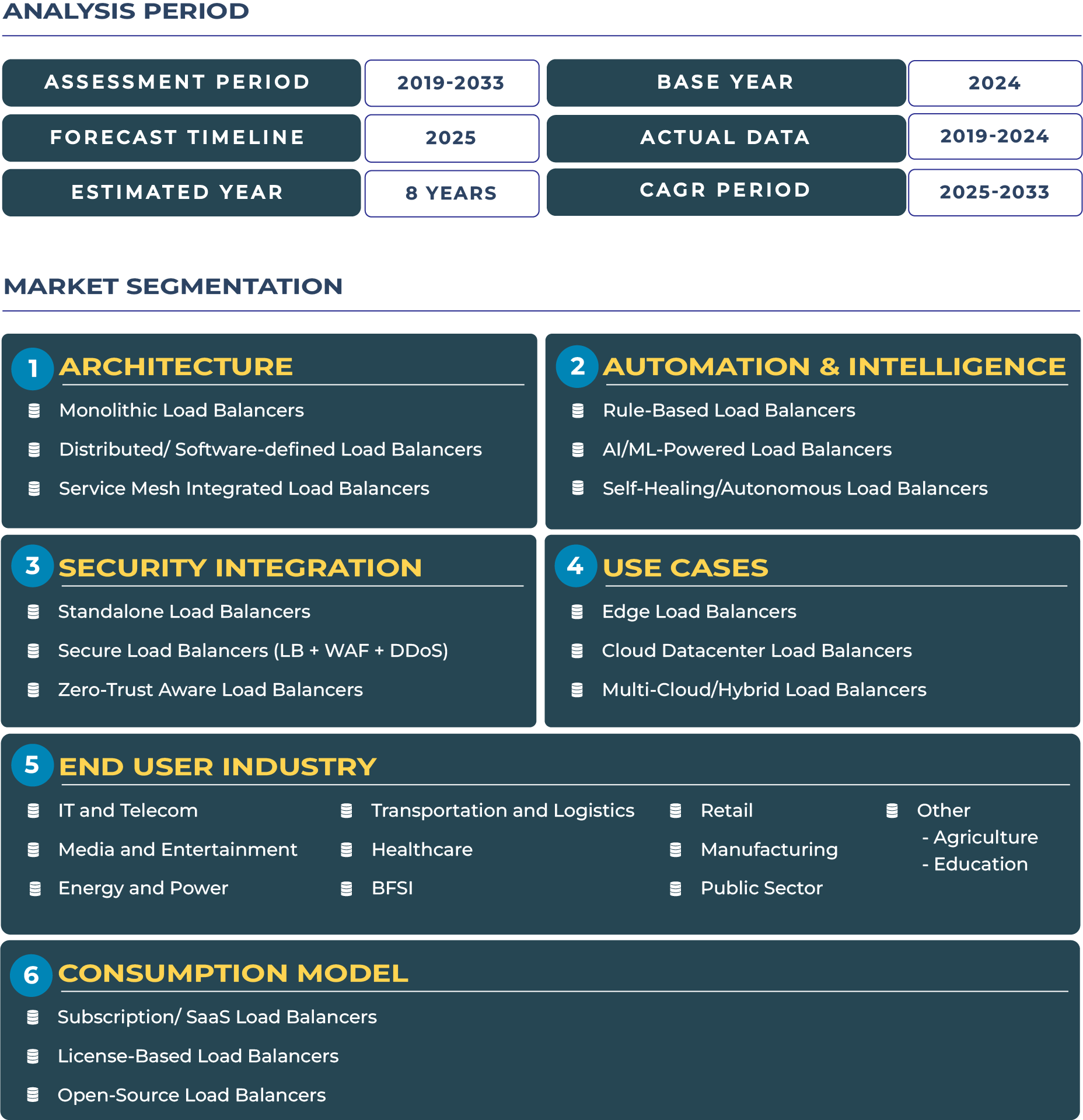Report Format:
![]()
![]() |
Pages: 110+
|
Pages: 110+
Taiwan Cloud Load Balancers Market Outlook: Tech Manufacturing Meets Cloud Services for a Scalable Future
The Taiwan cloud load balancers market is entering a pivotal growth phase as the island’s world-renowned semiconductor and electronics manufacturing base increasingly integrates with cloud-native services. Known as a global hub for chip production and advanced electronics, Taiwan is positioning itself as both a technology exporter and a cloud innovator. In 2025, the market is valued at USD 46.7 million and is projected to reach USD 163.9 million by 2033, expanding at a CAGR of 17.0%. This growth reflects the alignment of advanced enterprise IT, low-latency requirements in manufacturing, and adoption of distributed and software-defined load balancers to optimize application delivery.
As Taiwan deepens its role in the global supply chain, particularly through leaders like TSMC, the need for cloud load balancers becomes more pronounced to support edge computing for fabs, real-time data synchronization, and export-driven enterprise applications. The integration of private-cloud environments within fabs and broader digital modernization efforts makes the Taiwan cloud load balancers industry a cornerstone of the country’s digital economy.
Drivers and Restraints Shaping Taiwan’s Cloud Load Balancers Ecosystem
Market growth in Taiwan is driven by three core forces. First, the semiconductor and manufacturing demand continues to push enterprises toward resilient, high-performance load balancing to manage mission-critical workloads. Second, the rise of advanced enterprise IT adoption, particularly among export-oriented firms, accelerates the need for distributed load balancing and service mesh integration. Third, Taiwan’s export-driven tech sector demands scalable infrastructure that ensures global competitiveness through efficient digital services.
However, the industry also faces constraints. Taiwan’s smaller domestic market scale compared to larger regional peers limits the immediate scope of deployment. Additionally, geopolitical sensitivity in cross-strait relations introduces uncertainties for foreign investments and technology alignment. Furthermore, intense local competition among cloud and IT service providers places pricing pressures on premium load balancing solutions. These challenges underline the need for strategic positioning to sustain long-term market growth in the Taiwan cloud load balancers sector.
Emerging Trends and Opportunities Transforming the Taiwan Cloud Load Balancers Market
Several trends are reshaping Taiwan’s adoption of load balancing technologies. The expansion of edge and AI workloads for semiconductor fabs is driving demand for advanced traffic management across distributed architectures. Moreover, the rise of private-cloud environments for fabs enables enterprises to secure sensitive intellectual property while maintaining performance scalability. Collaboration between telcos and hyperscalers at the edge is also creating new pathways for delivering low-latency services in industrial zones and export hubs.
Opportunities are equally promising. Low-latency load balancing for manufacturing is becoming a high-value offering, ensuring smooth operations for real-time production systems. Enterprises are exploring private-cloud load balancers tailored to semiconductor fabs, where reliability and resilience are paramount. At the same time, system integrator (SI) partnerships are emerging as a key route to market, providing vertical-specific expertise and deployment scale. These opportunities solidify Taiwan’s potential to shape the cloud load balancers landscape across both domestic and global markets.
Competitive Landscape: Tailoring Cloud Load Balancers for Semiconductor and Export-driven Verticals
The Taiwan cloud load balancers ecosystem features both global players and local innovators. International providers such as F5 Networks have strengthened their presence by targeting Taiwan’s enterprise and semiconductor verticals. Strategies include offering customized SLAs for manufacturing workloads, ensuring reliability and uptime critical to production systems. Local players collaborate with National Communications Commission and industry consortia to integrate cloud services with national digital infrastructure goals.
Key developments in 2024 highlighted the growing importance of service mesh integrated load balancers for managing multi-cloud environments across semiconductor supply chains. Providers are tailoring solutions for enterprises that must balance global exports with localized compliance and security needs. As Taiwan strengthens its digital resilience, the cloud load balancers industry will be a strategic enabler of growth for both technology exports and domestic innovation.







